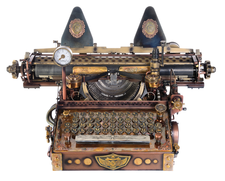An input device for keyboard shortcuts
Open Hardware – Palitra

© Lead Image © 3355m, 123RF.com
For even simpler keyboard shortcuts, the prospective Palitra allows you to create simple macros with a programmable USB device.
The keyboard is by far the most efficient way to interact with a computer. Pressing keys is faster than a mouse or trackball and reduces repetitive stress injuries, as well. For many, these advantages make learning keyboard shortcuts well worth the effort. Unfortunately, most non-gaming keyboards lack separate programmable keys, and shortcuts are often complex key combinations. Michele Balistreri's forthcoming Palitra offers simpler shortcuts: a programmable USB device for storing several dozen shortcuts. Palitra is scheduled for a crowdfunding campaign to assist manufacturing [1].
When he was 13, Balistreri first encountered open source software in a Corel Linux CD included in an Italian magazine. Since then, he has contributed to MPlayer and the icculus fork of Quake 2, briefly maintained KDE packages for Gentoo Linux, developed embedded software, and designed hardware.
Working as a fashion photographer inspired Balistreri to develop Palitra. He explains, "As a photographer, I spend a lot of time retouching, using a Wacom tablet and a keyboard for shortcuts. However, the typical keyboard is rather large and some combinations are hard to activate with one hand (especially being left handed). Often, my hand gets in the way of the stylus [for the tablet], and I cannot keep it constantly on the keyboard. To avoid shoulder ache and time wasting, I decided that I needed a small input device, which could be placed next to the tablet and programmed with all the shortcuts I need."
[...]
Buy this article as PDF
(incl. VAT)
Buy Linux Magazine
Subscribe to our Linux Newsletters
Find Linux and Open Source Jobs
Subscribe to our ADMIN Newsletters
Support Our Work
Linux Magazine content is made possible with support from readers like you. Please consider contributing when you’ve found an article to be beneficial.

News
-
Linux Mint 22.3 Now Available with New Tools
Linux Mint 22.3 has been released with a pair of new tools for system admins and some pretty cool new features.
-
New Linux Malware Targets Cloud-Based Linux Installations
VoidLink, a new Linux malware, should be of real concern because of its stealth and customization.
-
Say Goodbye to Middle-Mouse Paste
Both Gnome and Firefox have proposed getting rid of a long-time favorite Linux feature.
-
Manjaro 26.0 Primary Desktop Environments Default to Wayland
If you want to stick with X.Org, you'll be limited to the desktop environments you can choose.
-
Mozilla Plans to AI-ify Firefox
With a new CEO in control, Mozilla is doubling down on a strategy of trust, all the while leaning into AI.
-
Gnome Says No to AI-Generated Extensions
If you're a developer wanting to create a new Gnome extension, you'd best set aside that AI code generator, because the extension team will have none of that.
-
Parrot OS Switches to KDE Plasma Desktop
Yet another distro is making the move to the KDE Plasma desktop.
-
TUXEDO Announces Gemini 17
TUXEDO Computers has released the fourth generation of its Gemini laptop with plenty of updates.
-
Two New Distros Adopt Enlightenment
MX Moksha and AV Linux 25 join ranks with Bodhi Linux and embrace the Enlightenment desktop.
-
Solus Linux 4.8 Removes Python 2
Solus Linux 4.8 has been released with the latest Linux kernel, updated desktops, and a key removal.

